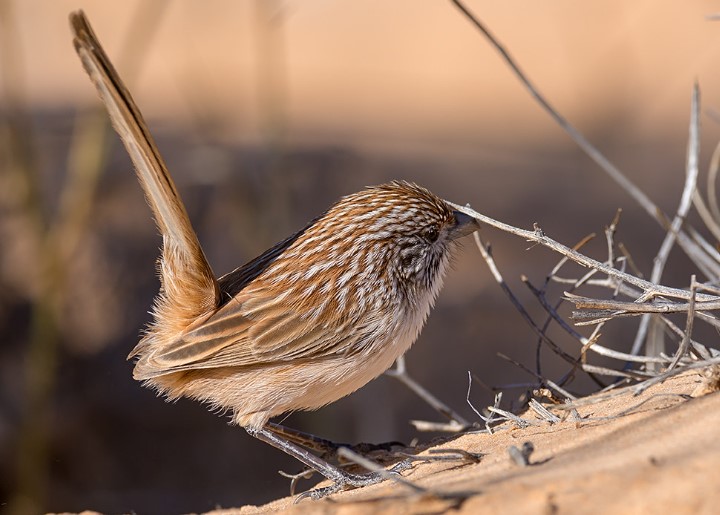Habitats: There is a species of Eastern Ground Parrot (Pezoporus wallicus) found in swampy heaths and pastures around the southern coast of Australia that is sparsely distributed, rare, and hard to spot. There are three ground-living parrots in the world, and this is one of them. The bird roosts by day in squats beneath tussocky vegetation, flushing reluctantly with an audible flutter before diving back into cover after having flown at least 50 meters.
During the night, when the birds feed their young, they do most of their foraging. Due to their long, slender, and clawed legs, they are able to run through dense foliage quickly and nimbly, as well as climb up on the seeding stalks; the waddling gait characteristic of other parrots is absent in them. The ground parrot is severely affected by the destruction of their habitat, resulting from too frequent burning and clearing along the coasts, destroying their habitat.
Behavior: Due to the absence of a furcula or wishbone attaching to the pectoral flight muscles, the parrot is thought to be able to take off vertically. The ground parrot is a strong flier and capable of flying long distances, contrary to popular belief. In spite of this, they seem to be sedentary and solitary; they tend to roost in pairs or groups.
During the flight, the bird follows a zigzag pattern low over the heathlands, alternating deep sweeping beats with down sweeping beats, followed by another series of beats in a different direction. The majority of ground parrots are nocturnal. As nightfall approaches, they become active and begin calling, fluttering over the heath. In calling, it is not clear whether the caller identifies themselves or advertises their territory. The song lasts for 30–40 minutes and is repeated at dawn. During the day, however, the birds are usually silent.
Five Ground-dwelling Parrots: In the world, there are only five species of ground-dwelling parrots. The eastern ground parrot is one of them, along with the western ground parrot (Pezoporus flaviventris), the night parrot (Pezoporus occidentalis), the remarkably rare night parrot (Pezoporus occidentalis), the somewhat closely related Antipodes parakeet ( Cyanoramphus unicolor), and the highly endangered kakapo (Strigops habroptilus from New Zealand).

Other Names: It is also known as Swamp Parrot and Button-Grass Parrot.
Size: Ground parrots have an average size of about 300–310 mm in length, with a long, slender tail.
Identification: As adults, there is no difference between the sexes. There is a narrow orange band on the front of the head. The head, neck, and mantle are green with black streaks, particularly in the crown and nape of the bird. There are green feathers on the back, wings, and rump of the bird that are centered with black and yellow, giving it a mottled appearance.
There is a broken yellow stripe running through the underside and the upper side of the flight feathers. A green tail feather has a yellow bar near the center, while a yellow bar near the outer tail feather has a dusky bar near the center. There is a green breast with a black feather shaft on it. It has green-yellow coverts on its belly, thighs, and undertail that are barred with black. The underwing coverts are green in color. Yellow is the color of the eyes.
The bill is gray-brown in color, and the cere is leaden in color. Generally, feet and toes are gray-buff in color; claws are darker and very long and slender in shape. IMMATURES: Unlike adults, there is no red frontal band; the head, neck, and breast are more heavily marked with black than they are as adults. There is a brown color to the eyes. DOWNY YOUNG: It is dusky-downey and yellow-billed.
Voice: The sound of the Eastern Ground Parrot is a thin, high-pitched call in the form of clear, measured, bell-like notes, tee-tee-stit or tee-tee-tee-stit, sometimes followed by sharper notes on an ascending scale, ending with drawn-out notes, tee-tee-tee-tee. Three to four whistles are sounded at the nest to announce the arrival.
Nesting and Breeding: The nesting and breeding process occurs between September and December of each year. A nest is usually found at the base of clusters or bushes, well overhung by sheltering vegetation, and consists of a large, shallow cup made from chewed stalks and leaves that is well hidden in soil and lined with chewed stalks and leaves.
Eggs and Incubation: In order to lay eggs, the parrot lays three or four white-colored eggs that are round in shape and measure approximately 27.8 x 23.0 mm in size. Incubation lasts for 21 days after the egg is laid. As soon as the young hatch, they leave the nest and take shelter in nearby plants until they are able to leave the nest completely.
Distribution: The Eastern Ground Parrot is seen sporadically along the southeast coast of Australia, from Fraser Island in Queensland to the southeastern part of South Australia. There are also some islands in Bass Strait, Tasmania, and along the south coast of Western Australia—from Irwin’s Inlet and Cheyne Beach to Israelite Bay—where they can be found.
Races: There are two races, one on the eastern coasts of the mainland and Tasmania with a greenish yellow belly barred completely black, and the other in Western Australia with a pure yellow belly barred incompletely black.
Status: There are only a few of these birds found in the world. In certain parts of their range, they are threatened not only by cultivation but also by foxes, cats, and fires. Their strong scent is very susceptible to being disturbed by dogs.
Scientific classification:
-
Family: Psittaculidae
-
Kingdom: Animalia
-
Order: Psittaciformes
-
Species: P. wallicus
-
Binomial name: Pezoporus wallicus
-
Phylum: Chordata
-
Class: Aves
-
Genus: Pezoporus






